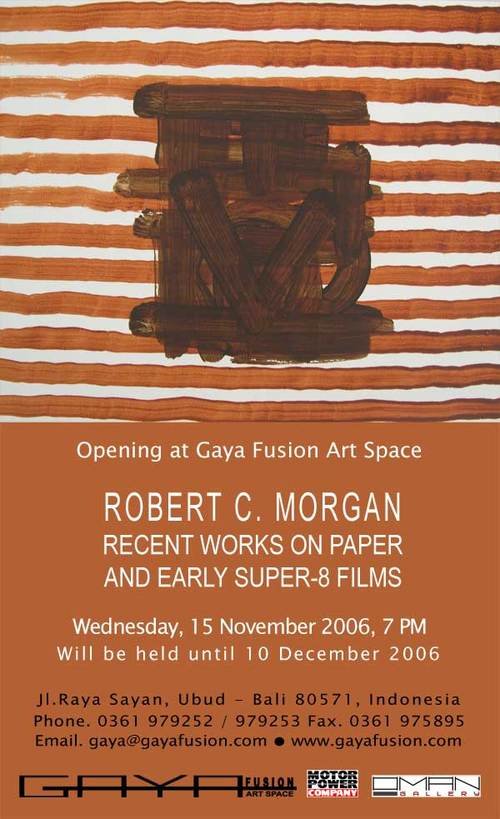Robert C. Morgan
dal 14/11/2006 al 14/12/2006
Segnalato da
14/11/2006
Robert C. Morgan
Gaya Fusion Art Space, Bali
Morgan has directed much of his attention to artists living in Asia, and his own exhibition brings to Indonesia his films and his works on paper. In the films, he appropriates images from mundane television culture and re-presents them without sound, leaving their sequence to determine the meaning.

Recent Works On Paper and Early Super-8 Films
Gaya Fusion Art Space is proud to present a very personal solo show by one of the great contemporary contributors to the history and theory of art.
Since receiving his Ph.D. in Art History in 1978, Robert C. Morgan has published over one thousand articles and reviews in more than fifty magazines, including Flash Art, Art News, Art in America, Tema Celeste, and Art Press; has taught at some of the top schools in the United States, including Columbia University, Pratt Institute, Hunter College, and the School of Visual Arts, New York; and is one of New York's most important curators, having organized major museum retrospectives of artists such as Allan Kaprow and Komar and Melamid. A full list of his books on conceptual art would fill this page.
But Robert C. Morgan is also a prolific artist whose own work has been shown at venues like the Whitney Museum of American Art, the OK Harris Gallery, and MOMA New York; and is included in major collections such as the Commodities Corporation, MOMA New York, Chase Manhattan Bank, Clark Art Institute and the Museum of Contemporary Art in Chicago.
In recent years, Robert C. Morgan has directed much of his attention to artists living in Asia, and his own exhibition at Gaya Fusion Art Space brings to Indonesia his films and his works on paper. In the films, he appropriates images from mundane television culture and re-presents them without sound, leaving their sequence to determine the meaning. This allows the viewer to see the images anew „Ÿ dumb electronic images „Ÿ in the form of a critique.
The works on paper are different. While also formed according to ideographic concepts, they are more an expression of love, a way of putting his identity to work in an oblique manner to create a foreign, alien, unknown work, filled with Korean letters and other script forms, geometric intricacies, bold lines, blocks of colour and vivid gestures. But the drawings nevertheless hold a symbolic content that is related to film. Each is also a framing device, a way of putting something in a frame that relates to another frame, a sequence in time and space. The pictures hold a kind of semiotic relationship to each other, to the kinetic expression of appropriated imagery, and to Dr. Morgan's personal recollections, his history and his thoughts „Ÿ perception and conception interactively positioned in relation to one another „Ÿ living the life of film, the sequential life of expressing moments in time, of giving something of himself in the process.
Opening: Wednesday, November 15, from 7 to 9 PM
Gaya Fusion Art Space
Jalan Raya Sayan, Ubud - Bali



